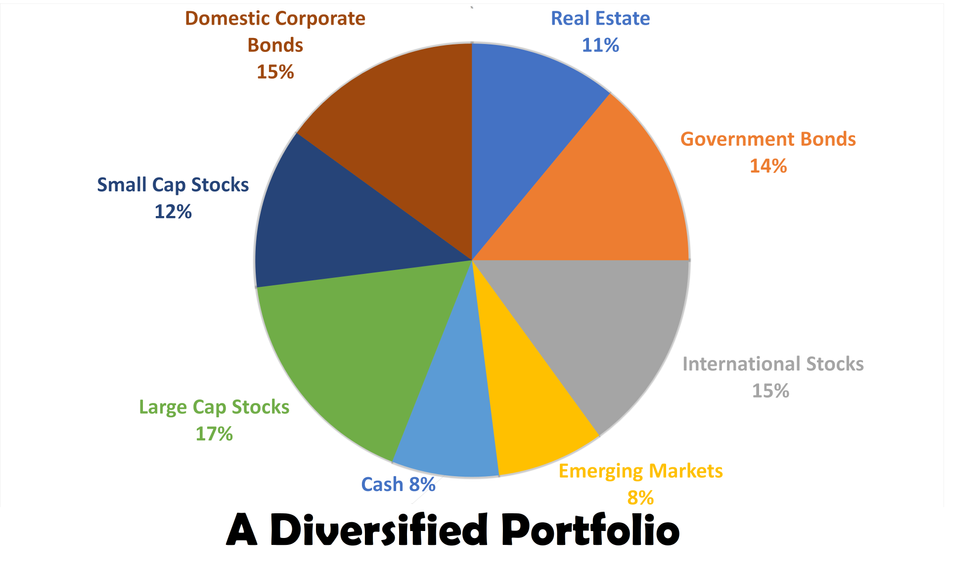Risk Management through Diversification in Trading- A Life Saver?

Let's say you invested a significant portion of your portfolio in a rising technology company, But, with its earnings report came some disappointing announcements. The result? Heavy losses to your portfolio.
Looking to avoid this scenario, you spread the risk and invested in the top 5 technology companies. Unfortunately, a negative news event occurred which impacted the entire sector, again causing significant losses to your portfolio.
This is why diversification in trading is necessary. By spreading your risk across multiple companies, sectors, and geographic regions, you can mitigate the impact of negative events on your overall portfolio.
In this blog post, we will discuss diversification in detail, explore diversification strategies, and provide a step-by-step approach on how to diversify your portfolio.
Let's start with the most basic question first...
What is diversification in trading?
Diversification is a risk management strategy that involves spreading your investments across different asset classes, industries, and companies. The goal of diversification is to reduce the overall risk of your portfolio by minimizing the impact of any one investment on your overall returns.
Diversification is like a safety net. Even if one sector slumps, others might hold their value or even rise, keeping your portfolio afloat.
Diversification Does not Maximise Return ( Not Necessarily!)
Here is another interesting aspect of Diversification.
While diversification is a cornerstone of sound investing, it's important to understand its primary function: risk management, not necessarily maximizing returns at any given moment.
It's true that some investors, by concentrating their capital in a few well-chosen investments, might achieve higher returns in the short term than a diversified portfolio.
However, the key word here is "might."
Picking those few winners consistently requires a level of foresight most investors simply don't have.
The market is unpredictable!
Diversification, on the other hand, aims for consistent and sustainable growth over the long term.
Statistics show that a diversified portfolio tends to outperform a majority of highly concentrated ones over extended periods.
Even the most experienced investors struggle to predict the future perfectly. Diversification acknowledges this challenge and provides a more balanced approach to navigate the uncertainties of the market.
Strategies for Diversification
Ok,
As an investor, If you have decided to diversify your portfolio, a wealth of Trading strategies awaits you. These methods are not mutually exclusive, and in fact, combining several approaches can significantly enhance the level of diversification within a single portfolio. Here's a glimpse of some of these strategies
Asset Class Diversification:
This is the foundation, spreading investments across asset classes like stocks, bonds, real estate, and commodities.
Stocks represent ownership in companies and generally offer the potential for high growth but also carry higher risk. Bonds, on the other hand, are loans to governments or corporations, providing steadier income but typically lower growth potential.
Investing in real estate, either directly through property ownership or indirectly through Real Estate Investment Trusts (REITs), adds another layer of diversification. Real estate tends to have a low correlation with stocks, meaning its value may not move in tandem with the stock market, offering a hedge against market volatility.
Also,
Commodities like gold, oil, and agricultural products can also be incorporated into a diversified portfolio. These assets may perform well during periods of inflation or economic uncertainty, providing stability when other asset classes struggle.
Industry Sector Diversification:
Industry sector diversification is about avoiding overconcentration in a single industry within your portfolio. This strategy spreads your investments across various sectors of the economy, each with its own unique drivers and risk profile.
Technology, for example, is at the forefront of innovation and can be a little volatile. Healthcare, on the other hand, can be a relatively stable sector during economic downturns. Consumer staples, like food and beverages, represent essential goods people need regardless of economic conditions. Financials, encompassing banks and insurance companies, are crucial to the functioning of the economy.
So,
Diversifying across these sectors acts as a hedge against industry-specific downturns. For example, if the technology sector experiences a correction due to a new regulation, a strong performance in the healthcare sector can potentially offset those losses within your portfolio.
There is one more point to consider here;
Some sectors tend to move in tandem with the overall market, while others exhibit lower correlation. Cyclical sectors, like technology or automotive, experience periods of boom and bust along with the economic cycle. Defensive sectors, like consumer staples or utilities, tend to be less volatile and offer more consistent returns.
Geographic Diversification:
Traditionally, investors focused on companies and assets within their own countries. However, geographic diversification encourages you to look beyond your home turf. This can be a rewarding strategy
Because;
Different regions around the world exhibit varying growth trajectories. By including international investments in your portfolio, you gain exposure to the high-growth potential of emerging markets or the stability of developed economies.
Similarly,
The performance of a single economy can be significantly impacted by local events or policies. Geographic diversification reduces your dependence on the success of your home country's economy. Even if your local market experiences a downturn, strong performance in other regions can help mitigate those losses and maintain overall portfolio growth.
Also,
This can be a Hedge against Currency Fluctuations;
Currencies constantly fluctuate in value relative to each other. Geographic diversification can act as a hedge against these fluctuations. When the value of your home currency weakens, the value of your international holdings denominated in a stronger currency might appreciate, potentially offsetting any losses.
Investment Style Diversification:
You can also consider incorporating different investment styles like value investing (focusing on undervalued stocks) or growth investing (focusing on high-growth potential companies) within your portfolio.
Value investors seek stocks that appear to be trading below their intrinsic value. They analyze a company's financial health, future potential, and current market price to identify undervalued stocks with the expectation that the price will eventually rise to reflect the company's true worth.
Value investing offers the potential for significant long-term capital appreciation, but it may require patience as undervalued stocks might take time to reach their full potential.
And Yes, Warren Buffet is a great example of Value Investor

Growth investors, on the other hand, focus on companies with the potential for high future growth. They look for companies with innovative products, strong management teams, and a clear path to market dominance. Growth stocks can offer impressive returns, but they also tend to be more volatile and may be more susceptible to market downturns.
Cathie Wood, CEO of ARK invest is an example of a value investor

So,
What should be your strategy?
Most of the experienced traders, tend to Find the right Balance depends on your individual risk tolerance and investment goals.
Aggressive investors might allocate a higher percentage to growth stocks for their high-growth potential, while conservative investors may favor value stocks for their stability and potential for dividend income.
Company Size Diversification:
Invest in a mix of large-cap (established companies), mid-cap (medium-sized companies), and small-cap (emerging companies) stocks. This provides exposure to different growth potentials and risk profiles.
Large-cap companies are the established giants of the industry, often household names with a long track record of success. Many large-cap companies have a history of paying regular dividends, providing a steady stream of income for investors.
Also,
Due to their established market position, large-cap stocks tend to be less volatile than smaller companies, meaning their price fluctuations are generally smaller.
But there is a catch!
While large-cap companies can still experience growth, it's typically slower and more predictable compared to smaller companies.
Mid-cap companies occupy the middle ground, offering a balance between the stability of large-cap and the higher growth potential of small-cap companies. They are often established players in their industries but have room for significant future expansion.
As a result, they offer more attractive growth opportunities compared to large-cap companies, but with some added volatility.
Some mid-cap companies may also start offering dividends as they mature, providing an additional income stream for investors.
But,
Compared to large-cap companies, mid-cap stocks carry a higher degree of risk due to their smaller size and potentially less established track record.
Small-cap companies are the young, innovative players in the market. They often have the potential for explosive growth, but also come with a significant amount of risk.
Since they are relatively new, small-cap companies may have a shorter track record, making it harder to assess their future prospects.
They can also tend to be much more volatile than their larger counterparts, meaning their prices can fluctuate dramatically.
So,
What should be your strategy?
By strategically allocating your investments across a mix of large-cap, mid-cap, and small-cap stocks, you can create a portfolio that captures the benefits of both stability and growth potential. Remember, the optimal mix for you will depend on your individual risk tolerance and investment goals.
Pros and Cons of Diversification:
Here is a Quick Comparison
|
Pros |
Cons |
|
Reduced Risk: Diversification helps spread
your risk across different investments. If one investment performs poorly,
the impact is lessened by the potentially good performance of others. |
Lower Potential Returns: A diversified portfolio may
not outperform a concentrated portfolio that "picks" the right
high-performing investments. |
|
Increased Stability: Diversification helps smooth
out the overall volatility of your portfolio, leading to a more stable ride
in the market. |
More Complex Management: Diversifying requires research
and monitoring of a wider range of investments. |
|
Exposure to Various
Opportunities:
Diversification allows you to tap into growth potential across different
asset classes, sectors, and geographic regions. |
Higher Costs: Depending on your chosen
diversification strategy, there might be additional fees associated with
investment vehicles like mutual funds or ETFs. |
|
Long-Term Growth: Diversification is a long-term
strategy that aims for consistent and sustainable growth over time. |
Challenges of Picking Winners: Even with diversification,
there's still an element of choosing the right asset allocation and
investment options. |
|
Reduced Emotional Investing: Diversification can help you
make more rational decisions by avoiding the temptation to chase hot trends
or panic-sell during market downturns. |
Less Control: With a diversified portfolio,
you have less control over the performance of individual investments. |
How to Diversify Your Investment Portfolio: A Step-by-Step Guide
Ok, so now you have a basic understanding of the concept, here is how to implement it for your portfolio Step by Step;
Step 1: Assess Your Risk Tolerance and Investment Goals
Before diving in, honestly assess your risk tolerance. Are you comfortable with high volatility and the potential for significant losses in exchange for the possibility of higher returns? Or do you prioritize stability and income over high growth?
In this step, you also need to define your long-term investment goals. Are you saving for retirement, a down payment on a house, or a child's education? The time horizon for each goal will influence your asset allocation strategy.
Step 2: Choose Your Investment Vehicles
As discussed above, Individual Stocks offer the potential for high returns but also carry higher risk. You can consider buying stocks in established companies from different sectors.
Mutual Funds, on the other hand, provide instant diversification by pooling your money with other investors and buying a basket of assets. Choose actively managed funds with specific investment objectives or passively managed index funds that track a market benchmark.
Exchange-Traded Funds (ETFs) are also similar to mutual funds but trade on stock exchanges throughout the day. Offer diversified exposure to specific asset classes, sectors, or geographic regions.
Step 3: Implement Asset Class Diversification
Stocks Offer the potential for capital appreciation but also carry market risk. The percentage you allocate to stocks will depend on your risk tolerance.
Bonds will Provide income and are generally considered less volatile than stocks. Consider government bonds, corporate bonds, or high-yield bonds depending on your risk tolerance and income needs.
Cash Equivalents Include low-risk options like money market funds or short-term CDs for easy access to cash and potential for a small return.
For sophisticated investors, consider real estate investment trusts (REITs) or commodities like gold for further diversification. However, these options often come with higher fees and complexity.
Step 4: Diversify Within Asset Classes
Even in one asset class, you need to diversify. You can spread your stock investments across various sectors like technology, healthcare, consumer staples, and financials to mitigate risk from industry-specific downturns.
You can also look beyond your home country and invest in international markets to tap into growth opportunities and reduce dependence on a single economy. Consider developed and emerging markets depending on your risk tolerance.
Also, Invest in a mix of large-cap, mid-cap, and small-cap stocks to gain exposure to different growth potentials and risk profiles.
Step 5: Rebalance Your Portfolio Regularly
Over time, the performance of different asset classes will cause your portfolio allocation to drift away from your initial target percentages. Rebalance your portfolio periodically (e.g., annually) to maintain your desired level of diversification.
Additional Tips:
Always Start Small
Begin with a basic level of diversification and gradually increase the complexity as you gain experience.
Do Your Research
Research individual investments or choose reputable mutual funds and ETFs with a solid track record.
Minimize Costs
Pay attention to fees associated with investment vehicles like mutual funds and ETFs. Consider low-cost index funds for a cost-effective diversification strategy.
Seek Professional Guidance:
For complex investment decisions, consider consulting a financial advisor who can create a personalized diversification plan based on your unique circumstances.
How much Diversification is enough?
Ok, so diversification is a crucial investment strategy, but there's a natural question that arises:
how much is enough?
Striking the right balance between diversification and potentially higher returns is key.
We know that Diversification can reduce risk and Increase Stability by giving Exposure to Various Opportunities.
However,
there are also Lower Potential Returns
So
Finding Your Balance is where it gets interesting.
There's no one-size-fits-all answer to how much diversification is enough. The optimal level depends on several factors like Risk Tolerance. Are you comfortable with high volatility and the potential for big losses for potentially higher returns? Risk-averse investors might favor a more diversified approach.
Similarly,
Investment Goals can also be a deciding factor. Are you saving for a short-term goal like a down payment or a long-term goal like retirement? Short-term goals might allow for a slightly less diversified approach aiming for higher returns.
So,
Here are some general guidelines:
If you have a Moderate Risk Tolerance,
You can consider a 60/40 portfolio allocation strategy – 60% in stocks for growth potential and 40% in bonds for stability. You can adjust this ratio based on your risk tolerance.
But, If you have a
Higher Risk Tolerance, You might allocate a higher percentage to stocks (70-80%) and a smaller percentage to bonds (20-30%). Explore sectors or asset classes with higher growth potential.
Similarly,
For Lower Risk Tolerance, You can allocate a larger portion to bonds (50-60%) and a smaller portion to stocks (40-50%). Focus on income-generating assets and prioritize capital preservation.
What are some good diversification strategies for beginners?
The world of investing can feel overwhelming for beginners. Here are some practical diversification strategies specifically for beginners to build a strong foundation for their investment journey:
1. Start Simple with the “power of three” for Asset Class Diversification:
Building a portfolio with three main asset classes is a great starting point. Allocate a portion of your investment to:
Stocks: Offer the potential for capital appreciation but also carry higher risk. Consider low-cost index funds that track a broad market index for a diversified exposure to stocks.
Bonds: Provide income and stability. Explore a mix of government bonds and investment-grade corporate bonds for a balance between risk and return.
Cash Equivalents: Include low-risk options like money market funds or short-term CDs for easy access to cash and potential for a small return.
2. Utilize Low-Cost Index Funds:
Index funds are a fantastic way to achieve diversification for beginners. They passively track a market index, automatically providing exposure to a basket of stocks or bonds within that index.
They also typically have lower fees compared to actively managed funds, making them a cost-effective way to invest.
Also, There are index funds available for various asset classes, sectors, and geographic regions. Choose index funds that align with your long-term goals and risk tolerance.
3. Leverage Target-Date Funds (Optional):
Target-date funds are a type of mutual fund designed to automatically adjust your asset allocation as you approach your target retirement date. This "set it and forget it" approach is ideal for beginners who want a hands-off investment strategy.
As you get closer to retirement, the fund will gradually shift your portfolio towards a more conservative allocation with a higher percentage of bonds for safety.
But,
Do your own Research Before Investing. While convenient, target-date funds might not be suitable for everyone. Understand the fees associated with these funds and ensure they align with your individual investment goals.
5. Start Small and Gradually Increase Complexity:
Yes, Start Small!
Begin with a basic level of diversification and gradually increase the complexity as you gain experience and confidence.
&
Invest Regularly!
Set up a recurring investment plan to consistently contribute to your portfolio, regardless of market fluctuations. This approach, known as dollar-cost averaging, helps smooth out the impact of entry points and encourages long-term investment discipline.
In Conclusion
Diversification isn't a magic bullet for guaranteed success, but it's a powerful tool that can significantly improve your odds in the often unpredictable markets. By strategically spreading your investments across different asset classes, sectors, and company sizes, you create a portfolio with built-in resilience. This approach helps you weather market fluctuations, minimize risk, and pursue your long-term financial goals with greater confidence. And above all, It helps you to
Trade Smarter!





